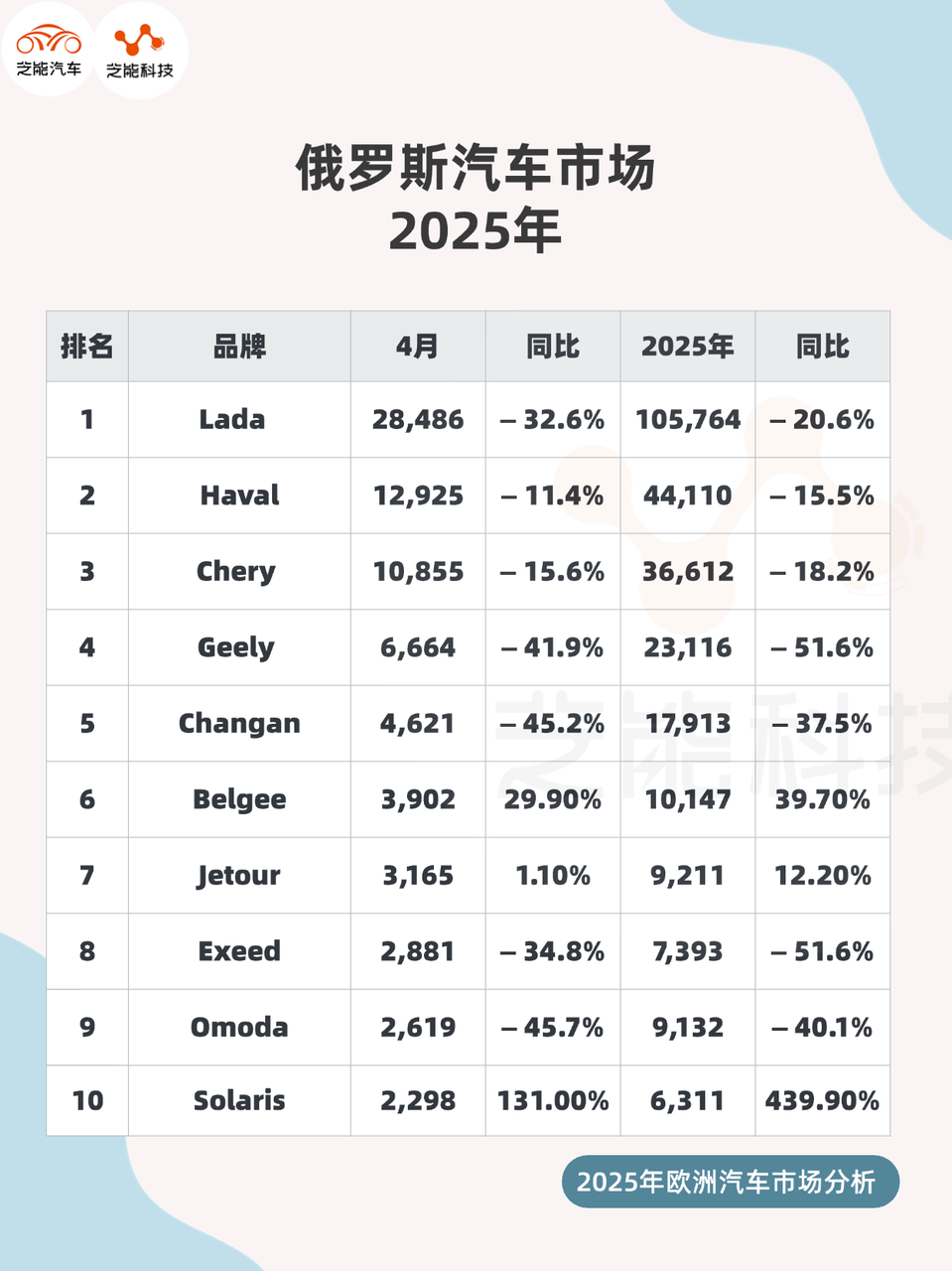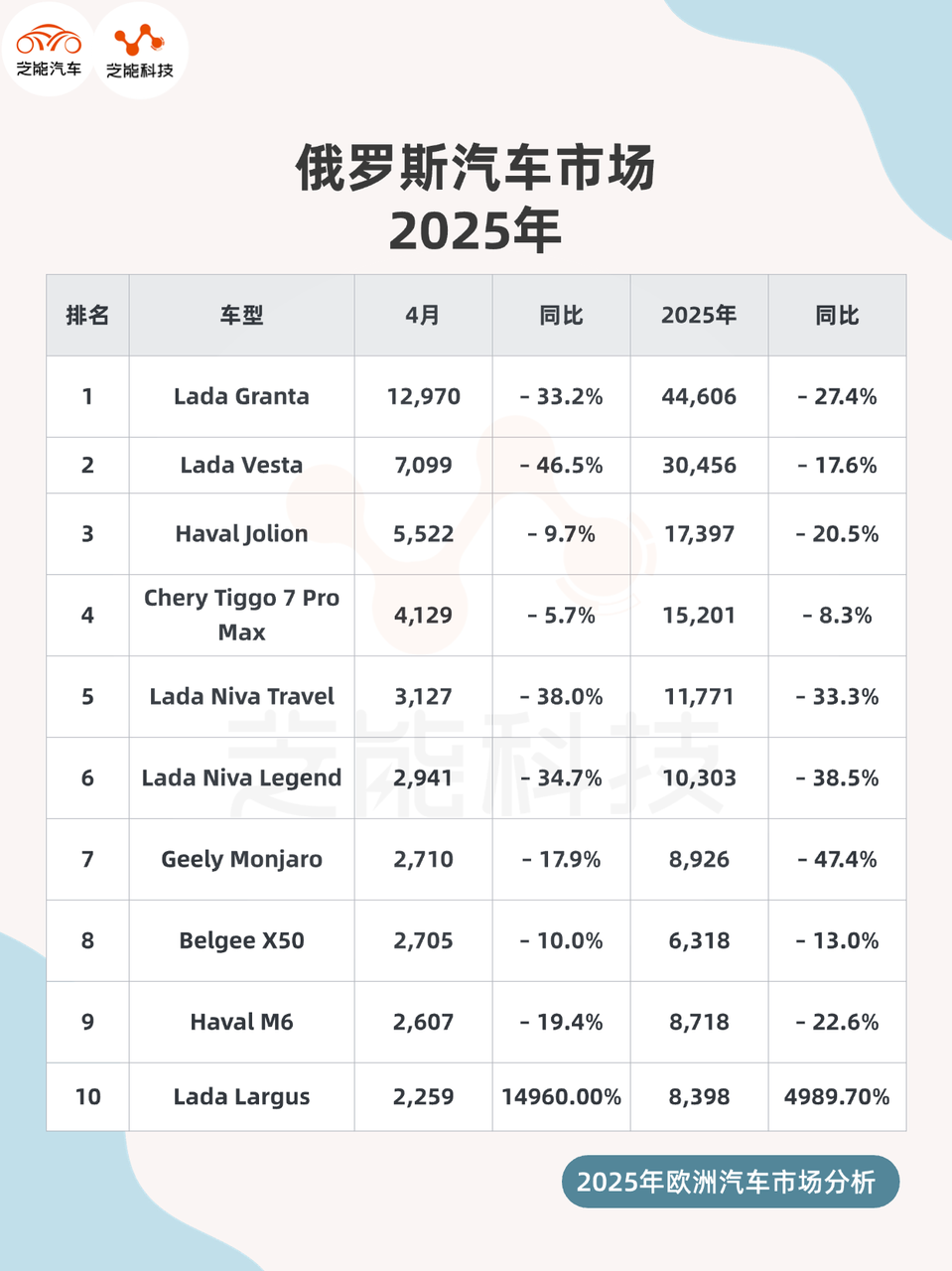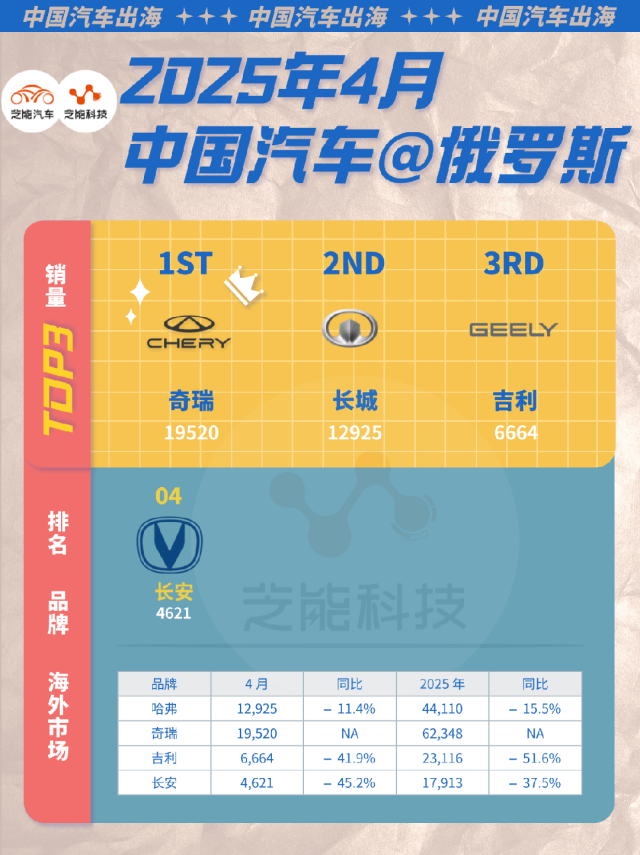European Auto Market | Russian Market Faces Another Tough Month in April, with Chinese Brands Leading the Charge
![]() 05/13 2025
05/13 2025
![]() 719
719

The Russian auto market endured a steep year-on-year decline of 25.5% in April 2025, marking the second consecutive month of double-digit drops. Cumulatively, the market contracted by 25.4% year-on-year in the first four months of the year.
Despite the overall market decline, Chinese brands like Belgee and Jetour demonstrated resilience, bucking the trend and emerging as bright spots in the challenging landscape.
This article delves into the structural shifts within the Russian auto market, examining overall performance, changes in brand dynamics, and the growth trajectories of Chinese brands.
01
Russian Auto Market: A Comprehensive Review of April 2025 Sales
In April 2025, sales of light vehicles in Russia plummeted to 102,107 units, a significant 25.5% drop from the previous year. Although the decline was less severe than March's 45.5% plunge, the market continued its downward spiral. Year-to-date, cumulative sales stood at 349,041 units, down 25.4% compared to the same period last year.
Key changes in the brand landscape saw local stalwart Lada losing ground.
Lada maintained its sales lead with 28,486 units, capturing 27.9% of the market share, but suffered a steeper year-on-year decline of 32.6%, outpacing the overall market's decline. This suggests that even in its home turf, Lada's dominance is being tested.

Chinese brands continued to hold a prominent position, yet differentiation among them intensified.
◎ Haval ranked second with 12,925 units, a modest 11.4% decline year-on-year, outperforming the market average.
◎ Chery placed third with sales of 10,855 units, down 15.6% year-on-year.
◎ Geely and Changan faced steeper declines, with sales of 6,664 units (-41.9%) and 4,621 units (-45.2%), respectively.
◎ Belgee and Jetour, however, achieved growth against the odds, reporting year-on-year increases of 29.9% and 1.1%, respectively. Belgee's market share reached 3.8%, surpassing Exeed and Omoda to enter the second tier of Chinese brands, underscoring the success of its product and channel strategies.

In the model sales landscape, Lada's traditional strongholds remained at the forefront.
◎ Lada Granta led the pack with 12,970 units, down 33.2% year-on-year but still ahead of its competitors.
◎ Lada Vesta ranked second with 7,099 units (-46.5%), experiencing a widened decline.
◎ Haval Jolion emerged as the most stable performer, ranking third with 5,522 units, a mere 9.7% decline year-on-year.
◎ Chery Tiggo 7 Pro Max placed fourth with 4,129 units, a slight 5.7% year-on-year decrease.
◎ A notable newcomer was Solaris, with sales of 2,298 units, up 131% year-on-year. Benefiting from the acquisition of Hyundai's factory in St. Petersburg, Solaris launched localized versions of multiple Hyundai models, quickly filling the void left by Hyundai's exit and demonstrating robust growth potential.
02
Russian Market Analysis of Chinese Brand Performance: The Strong Grow Stronger, Differentiation Sharpens
Amidst the overall market downturn, Chinese brands remained the "backbone" among foreign players, yet internal disparities widened.

Haval: Steady Leadership, Jolion as the Flagship Model
Haval sold 12,925 units in April, a decline of 11.4% year-on-year but demonstrating resilience relative to the market. Jolion, its primary sales driver, consistently ranked among the top three with monthly sales of 5,522 units, accounting for 42.7% of the brand's total sales. Its product strength, reliability, and cost-effectiveness have earned it a solid reputation among Russian consumers, underpinning Haval's ability to weather the market storm.
Chery: Steady Progress Amid Adjustments, Tiggo Family Propels Sales
Chery ranked third with sales of 10,855 units, led by the Tiggo 7 Pro Max (4,129 units), showcasing robust performance. Despite a 15.6% year-on-year decline, its sales remained at an acceptable level amidst the market downturn.
Notably, Chery's multi-brand strategy is diverting sales from its main brand. While sales of Omoda (2,619 units) and Exeed (2,881 units) are modest, their impact cannot be overlooked. It remains to be seen whether this strategy will lead to resource overlap and internal competition within the brand.
Geely and Changan: Setbacks in High-End Transformation, Sales Halved
Geely (6,664 units) and Changan (4,621 units) experienced significant year-on-year sales declines in April, reaching 41.9% and 45.2%, respectively.
Although Geely's flagship model Monjaro entered the top 10 (2,710 units), it failed to propel overall sales. The primary reason is that their more premium product positioning clashes with the weakened consumer confidence in Russia. With a notable mismatch in price range compared to Lada and Haval, their product competitiveness struggles to shine in the current macroeconomic environment.
Belgee and Jetour: Emerging Dark Horses Bucking the Trend
Belgee, a Belarusian-Chinese joint venture, sold 3,902 units in April, up 29.9% year-on-year. Its X50 model sold 2,705 units, entering the top 10 for the first time, a remarkable achievement. Belgee's strength lies in sharing a technology platform with Geely while benefiting from local manufacturing advantages, avoiding certain policy hurdles.
Jetour, an emerging brand under Chery, witnessed a slight year-on-year sales increase of 1.1%, with 3,165 units. Its steady growth is attributed to its cost-effectiveness and product size advantages.
Summary
Despite the severe decline in the Russian market in April 2025, Chinese brands overall demonstrated resilience. Companies like Haval and Chery maintained stable output, while emerging brands such as Belgee and Jetour showed growth potential, emerging as dark horses in the automotive landscape.





